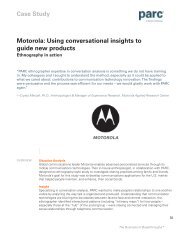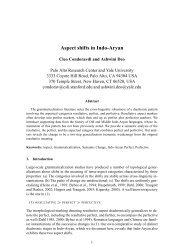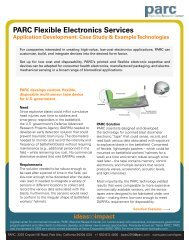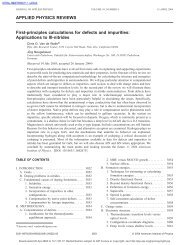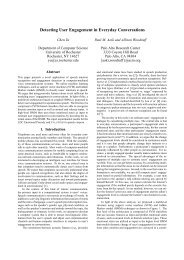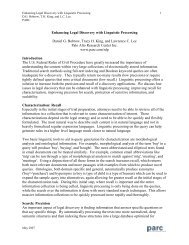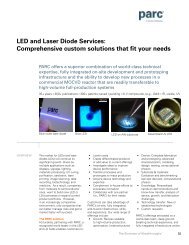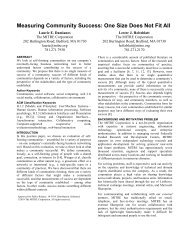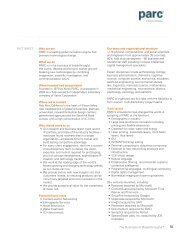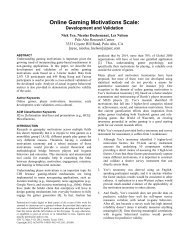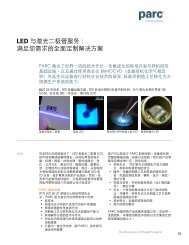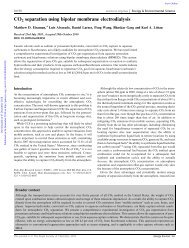Co-Extrusion Printing for Battery Electrodes: Novel co ... - Parc
Co-Extrusion Printing for Battery Electrodes: Novel co ... - Parc
Co-Extrusion Printing for Battery Electrodes: Novel co ... - Parc
Create successful ePaper yourself
Turn your PDF publications into a flip-book with our unique Google optimized e-Paper software.
<strong>Co</strong>-<strong>Extrusion</strong> <strong>Printing</strong> <strong>for</strong> <strong>Battery</strong> <strong>Electrodes</strong>:<br />
<strong>Novel</strong> <strong>co</strong>-extrusion printing technique improves<br />
battery per<strong>for</strong>mance<br />
PARC offers a proven <strong>co</strong>-extrusion printing technique that can enhance<br />
both the energy and power densities of batteries. A <strong>co</strong>st-effective way to<br />
manufacture structured electrodes, this technique can be applied to both<br />
cathodes and anodes <strong>for</strong> most battery chemistries.<br />
Interdigitated <strong>co</strong>-extrusion printed battery electrode<br />
<strong>Co</strong>-extrusion printed cathode<br />
(Li<strong>Co</strong>O 2 ) from one print head<br />
OVERVIEW:<br />
One of the challenges in transitioning from<br />
fossil fuels to renewable energy is the<br />
availability of <strong>co</strong>st-effective and portable energy<br />
storage. For instance, the development of more<br />
efficient batteries at low <strong>co</strong>st is crucial <strong>for</strong> the<br />
growth of the electric vehicle market. However,<br />
given the limited space available within a<br />
battery cell, per<strong>for</strong>mance is typically optimized<br />
<strong>for</strong> either power or energy density. With typical<br />
monolithic battery electrodes, increased power<br />
requires greater <strong>co</strong>nductivity, thereby resulting<br />
in less available volume <strong>for</strong> energy storage.<br />
By structuring an electrode with <strong>co</strong>nductive<br />
regions that are interleaved with storage<br />
regions, current paths can be shortened<br />
without <strong>co</strong>mpromising capacity. PARC’s<br />
innovative <strong>co</strong>-extrusion printing technique can<br />
fabricate such structures at high speed. The<br />
relative dimensions can be changed to achieve<br />
optimal per<strong>for</strong>mance in terms of both power<br />
and energy.<br />
The benefits<br />
• Up to 20% increase in energy density<br />
• Up to 20% increase in power density<br />
• Up to 20% decrease in <strong>co</strong>st ($/Wh)<br />
• Transferrable to mass manufacturing<br />
• Scalable to manufacture higher capacity<br />
batteries<br />
• Applicable to most battery chemistries
The solution<br />
PARC has developed an innovative<br />
<strong>co</strong>-extrusion printing technique where<br />
dissimilar materials can be deposited side<br />
by side at high speed. This technique can<br />
directly deposit an interdigitated structure as<br />
small as 1um in width with high aspect ratios.<br />
By changing the print head geometry, the<br />
relative thickness, width, and length of the<br />
deposited structure can easily be modified.<br />
PARC originally developed this technique to<br />
print metal gridlines with high aspect ratios<br />
on solar cells, and it has been successfully<br />
integrated into a pilot production line of a solar<br />
cell manufacturing client.<br />
The technique can be applied to battery<br />
chemistries where electrodes are <strong>co</strong>ated on<br />
metal foils from a slurry, and its process<br />
speed, <strong>co</strong>ating width, and reliability are<br />
equivalent to those of <strong>co</strong>nventional battery<br />
<strong>co</strong>ating equipment.<br />
The per<strong>for</strong>mance<br />
PARC fabricated Li<strong>Co</strong>O 2 half cells using<br />
the <strong>co</strong>-extrusion printing technique and<br />
is currently analyzing the results. Also,<br />
per<strong>for</strong>mance modeling is being <strong>co</strong>nducted<br />
with different battery chemistries, including<br />
alkaline, Li x Mn 2 O 4 , Li<strong>Co</strong>O 2 , Zn-air, and Ag-Zn.<br />
For example, the modeling of a <strong>co</strong>-extruded<br />
structured cathode in a Li-ion battery resulted<br />
in a 10-20% improvement in energy density<br />
at the same power output. Applying the<br />
technique to anodes, additional improvements<br />
can be expected.<br />
Take action<br />
PARC is interested in working with battery<br />
manufacturers who want to use PARC’s<br />
innovative technique to improve their current<br />
battery per<strong>for</strong>mance without changing the<br />
fundamental chemistry.<br />
Please <strong>co</strong>ntact Business Development:<br />
engage@parc.<strong>co</strong>m<br />
Example benefits of <strong>co</strong>-extrusion printing technique<br />
PARC, a Xerox <strong>co</strong>mpany, is in The Business of Breakthroughs ® . Practicing open innovation, we provide<br />
custom R&D services, technology, expertise, best practices, and IP to global Fortune 500 and Global 1000<br />
<strong>co</strong>mpanies, startups, and government agency partners. We create new business options, accelerate time<br />
to market, augment internal capabilities, and reduce risk <strong>for</strong> our clients.<br />
PARC, 3333 <strong>Co</strong>yote Hill Road, Palo Alto, Cali<strong>for</strong>nia 94304 USA +1 650 812 4000 | engage@parc.<strong>co</strong>m | www.parc.<strong>co</strong>m<br />
© Palo Alto Research Center In<strong>co</strong>rporated<br />
DS.BATTERY.ELECTRODES1000022712



